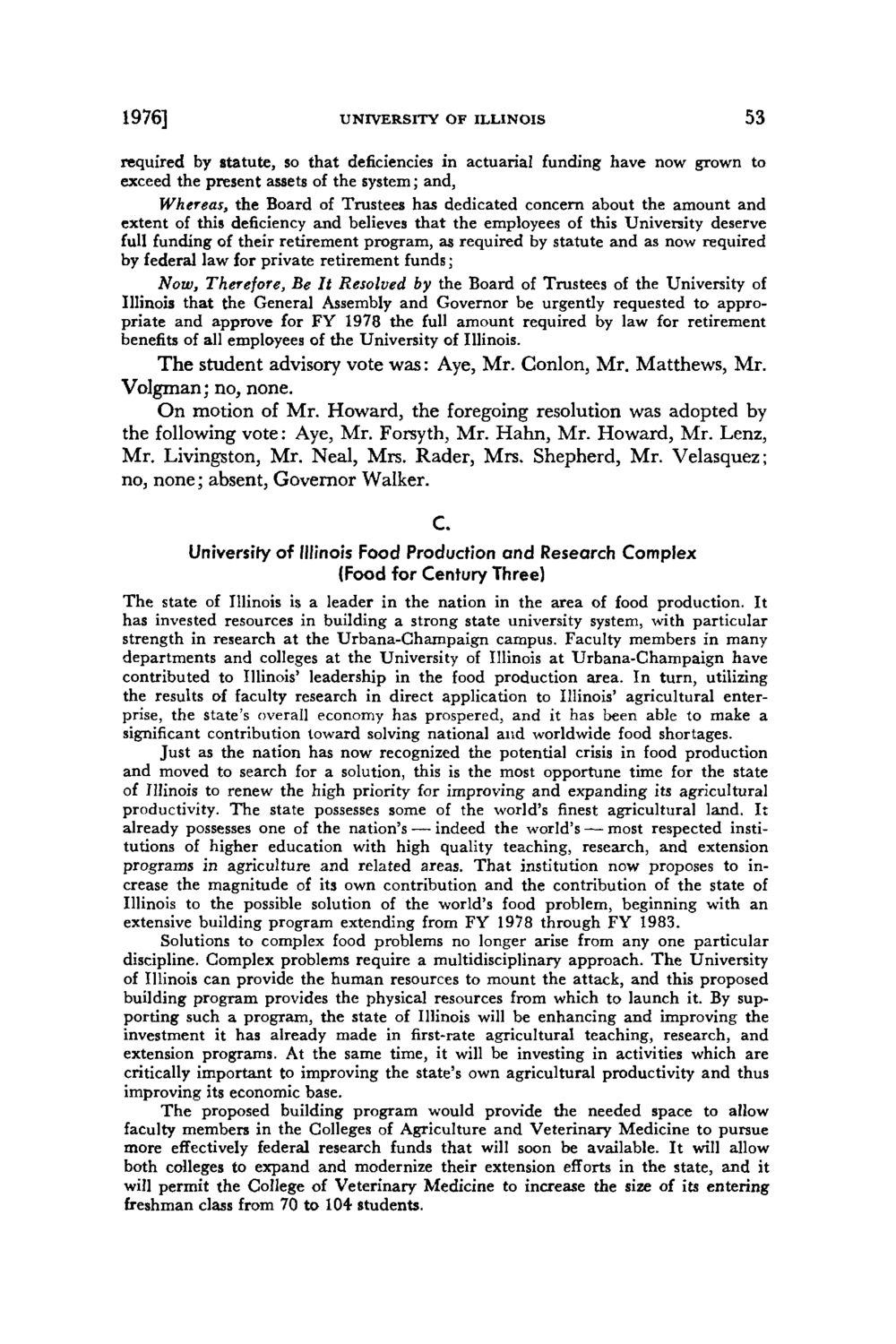| |
| |
Caption: Board of Trustees Minutes - 1978
This is a reduced-resolution page image for fast online browsing.

EXTRACTED TEXT FROM PAGE:
1976] UNIVERSITY OF ILLINOIS 53 required by statute, so that deficiencies in actuarial funding have now grown to exceed the present assets of the system; and, Whereas, the Board of Trustees has dedicated concern about the amount and extent of this deficiency and believes that the employees of this University deserve full funding of their retirement program, as required by statute and as now required by federal law for private retirement funds; Now, Therefore, Be It Resolved by the Board of Trustees of the University of Illinois that the General Assembly and Governor be urgently requested to appropriate and approve for FY 1978 the full amount required by law for retirement benefits of all employees of the University of Illinois. The student advisory vote was: Aye, Mr. Conlon, Mr. Matthews, Mr. Volgman; no, none. On motion of Mr. Howard, the foregoing resolution was adopted by the following vote: Aye, Mr. Forsyth, Mr. Hahn, Mr. Howard, Mr. Lenz, Mr. Livingston, Mr. Neal, Mrs. Rader, Mrs. Shepherd, Mr. Velasquez; no, none; absent, Governor Walker. C. University of Illinois Food Production and Research Complex (Food for Century Three) The state of Illinois is a leader in the nation in the area of food production. It has invested resources in building a strong state university system, with particular strength in research at the Urbana-Champaign campus. Faculty members in many departments and colleges at the University of Illinois at Urbana-Champaign have contributed to Illinois' leadership in the food production area. In turn, utilizing the results of faculty research in direct application to Illinois' agricultural enterprise, the state's overall economy has prospered, and it has been able to make a significant contribution toward solving national and worldwide food shortages. Just as the nation has now recognized the potential crisis in food production and moved to search for a solution, this is the most opportune time for the state of Illinois to renew the high priority for improving and expanding its agricultural productivity. The state possesses some of the world's finest agricultural land. It already possesses one of the nation's — indeed the world's — most respected institutions of higher education with high quality teaching, research, and extension programs in agriculture and related areas. T h a t institution now proposes to increase the magnitude of its own contribution and the contribution of the state of Illinois to the possible solution of the world's food problem, beginning with an extensive building program extending from FY 1978 through FY 1983. Solutions to complex food problems no longer arise from any one particular discipline. Complex problems require a multidisciplinary approach. T h e University of Illinois can provide the human resources to mount the attack, and this proposed building program provides the physical resources from which to launch it. By supporting such a program, the state of Illinois will be enhancing and improving the investment it has already made in first-rate agricultural teaching, research, and extension programs. At the same time, it will be investing in activities which are critically important to improving the state's own agricultural productivity and thus improving its economic base. T h e proposed building program would provide the needed space to allow faculty members in the Colleges of Agriculture and Veterinary Medicine to pursue more effectively federal research funds that will soon be available. It will allow both colleges to expand and modernize their extension efforts in the state, and it will permit the College of Veterinary Medicine to increase the size of its entering freshman class from 70 to 104 students.
| |